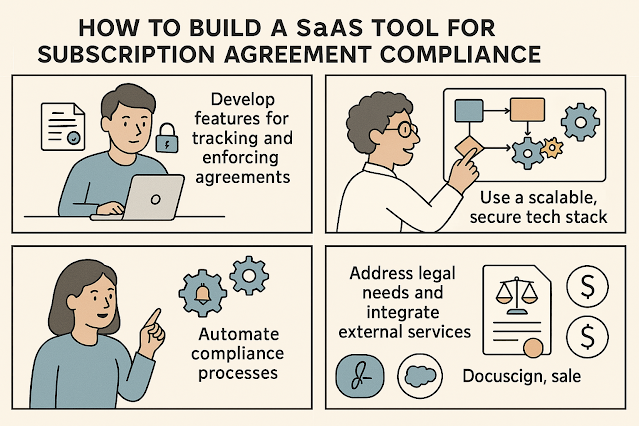How to Build a SaaS Tool for Subscription Agreement Compliance
How to Build a SaaS Tool for Subscription Agreement Compliance
In today’s subscription economy, ensuring customers agree to—and remain in compliance with—subscription terms is more than a legal requirement.
It’s a critical part of customer trust, data security, and recurring revenue stability.
This guide will walk you through how to build a SaaS tool designed to help companies manage and enforce compliance with subscription agreements.
📌 Table of Contents
- Why Compliance Matters in SaaS
- Core Features of a Compliance SaaS Tool
- Choosing the Right Tech Stack
- Automation & Workflow Integration
- Legal Considerations & Data Policies
- External Services & API Integrations
- Conclusion
🌐 Why Compliance Matters in SaaS
Subscription agreements are binding legal documents that define how customers engage with your service.
From cancellation policies to data usage terms, violating these terms can result in fines, legal disputes, or loss of trust.
A compliance SaaS tool helps automate these processes to minimize human error and ensure continued alignment with legal and business goals.
🧰 Core Features of a Compliance SaaS Tool
Your tool should focus on key modules that support user agreement tracking and policy enforcement:
- E-signature and version-tracking of subscription agreements
- Real-time notification of policy changes
- User access control based on agreement version
- GDPR and HIPAA flagging where applicable
Make sure that every compliance action is logged and auditable.
This adds trust and simplifies external audits.
🧪 Choosing the Right Tech Stack
Go for a modern, scalable, and secure stack:
- Backend: Node.js or Python with frameworks like FastAPI or Express.js
- Frontend: React or Vue.js for dynamic UI
- Database: PostgreSQL or MongoDB with encrypted fields
- Hosting: AWS or Google Cloud with multi-region support
Security should be built-in from the start—consider Zero Trust models and OAuth2 for authentication.
⚙️ Automation & Workflow Integration
Automation is where your SaaS shines.
Use logic-based workflows that trigger alerts when users violate policies.
Integrate with tools like Zapier or Integromat to push updates to CRM, email, or project tools.
Consider integrating ML models to flag potential risky users based on activity trends.
📜 Legal Considerations & Data Policies
Your SaaS must stay current with global legal frameworks.
This includes GDPR, CCPA, and industry-specific laws like SOC 2 or HIPAA.
Use dynamic templates to localize agreements by region.
Also, implement version control for every agreement update to avoid retroactive liability.
🔌 External Services & API Integrations
To enhance value, allow integration with third-party services such as:
- DocuSign or HelloSign for digital signatures
- Salesforce and HubSpot for CRM syncing
- Stripe or Recurly for billing validation
This reduces redundancy and increases your product’s stickiness across an organization.
🧠 Conclusion
Building a SaaS tool for subscription agreement compliance requires a balance of legal insight, technical architecture, and UX finesse.
By prioritizing automation, transparency, and integration, your product can deliver both peace of mind and tangible value to businesses navigating the complexities of the modern subscription economy.
As regulatory demands grow, tools that ensure compliance will be essential—not optional—for SaaS companies looking to scale globally.
Start small, iterate quickly, and stay updated with evolving laws and user expectations.
Keywords: SaaS compliance, subscription agreement software, GDPR automation, legal tech SaaS, policy enforcement tools
